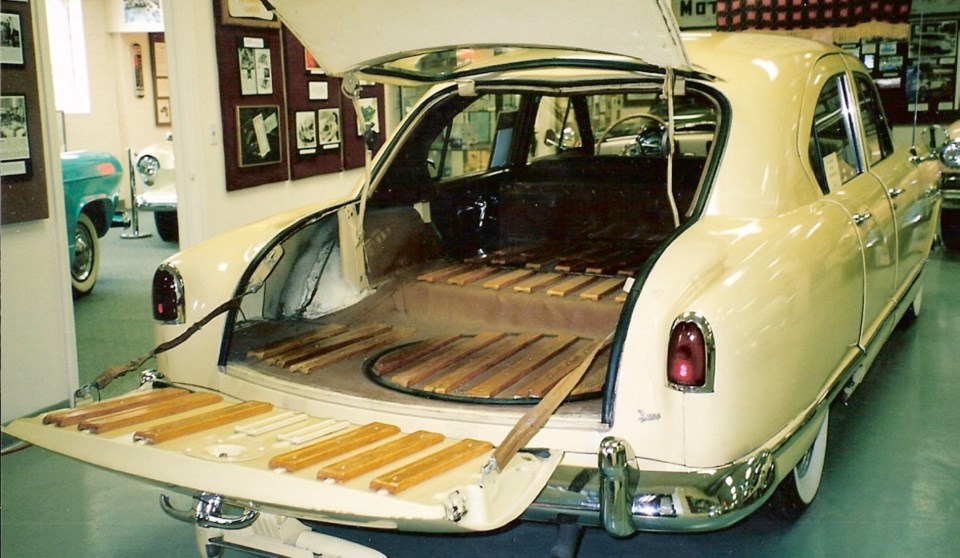The hatchback is a versatile automobile body style, and when it began making its appearance in quantity in the 1970s, its practicality made it very popular, especially in Europe. Although its market share has faded a little in favour of crossovers and SUVs in North America, it is still a useful configuration. Like so many automotive features, it wasn’t really new; the hatchback had first appeared on Kaiser-Frazer cars about a quarter-century earlier.
Kaiser-Frazer was a post-Second World War automobile company formed when Graham-Paige president Joseph Frazer and construction millionaire Henry Kaiser teamed up in 1945 to create the Kaiser-Frazer Corp. In doing so, they launched what American auto historian Richard Langworth in his book on Kaiser-Frazer history called “the last onslaught on Detroit.”
Frazer started as a mechanic with the Packard Motor Car Co., but decided a better future lay in sales. He progressed through increasingly responsible auto industry positions until the end of the Second World War found him with a controlling interest in Graham-Paige Motor Corp. Although G-P was active in military work, it hadn’t built a car since 1940.
Kaiser’s money came from construction contracts that read like a who’s-who of 1930s megaprojects: the Grand Coulee, Bonneville, and Boulder (now Hoover) dams; the San Francisco-Oakland Bay Bridge; and a third set of locks for the Panama Canal. He built Liberty ships during the Second World War.
Kaiser-Frazer Corp. obtained the Willow Run war surplus bomber plant near Ypsilanti, Michigan, and produced its first prototype car in early 1946. By June 1946, an astonishingly short period, K-F was in production with 1947 models.
The corporation built both Kaisers and Frazers, which shared bodies and chassis. The Frazer was trimmed more luxuriously to compete with such marques as Oldsmobile, Chrysler and Hudson. The Kaiser’s price was kept more moderate for the popular-priced segment.
K-F prospered by riding the crest of the postwar new-car shortage, producing almost 140,000 cars in 1948. But they did not offer a station wagon or utility vehicle, which contributed to K-F’s development of the hatchback.
Henry Kaiser is reputed to have conceived the hatchback idea. It incorporated the amenities of a sedan with cargo space approaching that of a station wagon. According to company lore, Henry Kaiser took his design staff down to the garage in the Kaiser building and outlined his idea by drawing some lines on the back of a dusty company car. Kaiser reportedly said: “Why not cut a door in the rear and divide it halfway down the trunk lid? Then hinge it here and here, find some way of folding down the rear seat.”
Following Kaiser’s direction, K-F staff developed the kind of vehicle he outlined. A large hatch was created incorporating the rear window and extending down to the middle of the trunk lid. The roof was reinforced to support the hatch and the tailgate-like section of the trunk lid was hinged at bumper level.
The rear seat was designed to fold forward, and because there was now no space in the trunk for the spare tire it was bolted to the inside of the left rear door, which was usually welded shut. Raising the hatch, folding the seat and lowering the tailgate created a long, level load platform.
Henry Kaiser’s instincts had been good. The versatile Kaiser Traveler and companion Frazer Vagabond were an instant sales success. Priced at less than $100 above the sedans, placing it much below competitive station wagons, the Traveler/Vagabond accounted for about one-quarter of 1949 Kaiser-Frazer production.
Others tried to imitate K-F’s innovative idea, without their success. Chrysler Corp.’s 1949 Chrysler and De Soto “Carryall” models were intended to match the Traveler/Vagabond’s versatility, but lacked the unique rear hatch.
The Frazer name was dropped in 1951 after Joseph Frazer left the company following a disagreement with the management style of Henry Kaiser and his son Edgar. With the attractively styled new 1951 Kaisers, a way was found to stow the spare tire in the trunk. This added to the Traveler’s appeal by making it a four-door hatchback. The Kaiser Traveler utility model was continued until 1953.
Kaiser-Frazer’s valiant attempt to challenge established manufacturers, including the Big Three (General Motors, Ford and Chrysler), came to an end in North America in 1955. But it proved that smaller companies can be more versatile, and part of its lasting legacy was the pioneering and innovative hatchback body style.



